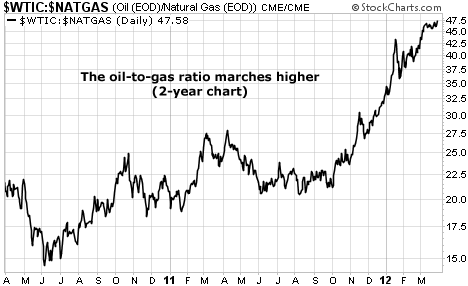| Home | About Us | Resources | Archive | Free Reports | Market Window |
A Resource Legend's "Radical" Trading ApproachBy
Saturday, March 31, 2012
Rick Rule is taking a "radical" approach to natural resource stocks these days...
Actually, what's "radical" for Rick is "typical" for most people. But his current take on the market could make you triple-digit returns over the next few years.
Regular DailyWealth readers have seen Rick's name many times. Rick is a natural resource investing legend. Over the past three or so decades, he's made a fortune for himself and his investors by buying cheap, out-of-favor resource assets (things like copper mines and oil fields)... and selling them when the world wants them. Some of the smartest, richest investors I know use Rick's firm (which is now part of Sprott USA) exclusively to make natural resource investments.
At any given time, when Rick looks over the resource investment landscape, he typically sees the most opportunity in very small resource stocks. Not many people follow this space, so there's a better chance of finding cheap, safe stocks.
But these days, Rick is taking a "radical" approach. He's seeing incredible values in "Big Mining"...
Over the past few years, commodities like gold and copper have soared in price. Gold was $1,000 an ounce in 2009. Now it's $1,660. Copper was $2 a pound in 2009. Now it's $3.80. But rather than climb along with the price of metals, big mining firms have declined... or traded sideways. Most people just don't believe the price of commodities can stay this high... So they are avoiding these stocks.
Meanwhile, big mining firms like Freeport-McMoRan and Kinross Gold are raking in huge amounts of cash. This "falling stock price, surging cash flow" situation is making big miners very cheap.
For example, Freeport-McMoRan is one of the world's great copper miners. It owns two extraordinary mines, Grasberg and Tenke Fungurum. Its shares are down 30% in the past year.
Freeport's market cap is about $36 billion. In 2011, it generated $6.6 billion from its copper and gold mines. That means the company trades for just 5.4 times its cash flow. That's incredibly cheap.
Another great example is Kinross Gold. Kinross is the sixth-largest gold producer in the world. It's poised for solid production growth over the coming years... And it's spinning out enormous amounts of cash. Kinross shares have fallen 37% in the past year.
Kinross' market cap is about $11 billion. In 2011, it generated $1.6 billion from its gold mines. Today, Kinross trades for just 6.8 times cash flow. And like Freeport, it's incredibly cheap.
I recognize the fears related to owning big mining stocks. Many folks think China's economy will suffer a big slowdown, which will depress demand for commodities... which will depress commodity prices... which will depress the share price of commodity producers. But if China simply "treads water"... and if commodity prices simply stay at current levels... big mining firms will continue to make huge amounts of money.
As we say in response to extremely bearish financial forecasts, the world has a way of not ending... and rewarding optimists.
In sum, it's not often a guy like Rick Rule gets into "Big Mining." It takes extraordinary values to get him interested. Right now, those values exist. If the world simply doesn't end – and commodities simply stay at their current prices – buying now will look like a brilliant move a few years from now.
Good investing,
Matt Badiali
Further Reading:
Before you invest a dime in natural resource stocks, it's crucial you understand the cyclicality of the resource markets. So our sister site, The Daily Crux, caught up with master commodities investor Rick Rule to learn more. "Catch one of these big cycles early, and you may never have to work again," he said. "Catch one at the wrong time, and you'll lose a fortune..."
If you're looking to make life-changing profits from commodities and resource stocks, you can't miss this interview. It's completely free for Crux subscribers. Learn more here.
Market NotesCHART OF THE WEEK: THE GREATEST ENERGY BARGAIN ON THE PLANET Another week, another new high in the "oil-to-gas" ratio.
Regular DailyWealth readers know how new drilling technologies have allowed us to access huge new supplies of domestic natural gas. This supply surge has pushed gas to bargain-basement levels.
Like its energy cousin oil, natural gas has many uses. It's used as a building block to make chemicals, fertilizers, and plastics. It's also used to fire power plants and heat homes and factories. And it's becoming widely used as a motor fuel.
Over the past year, we've shown you how falling natural gas prices have produced a series of new highs in the oil-to-gas ratio. This ratio compares the cost of oil versus natural gas.
Years ago, this ratio drifted between six and 10. Sometimes, the ratio would even spike to 14, which indicated really cheap natural gas. In January, the ratio spiked to 35. And just this week, the ratio hit another new all-time high of 47. We state again: U.S. natural gas is the greatest energy bargain on the planet... and it's becoming one of America's greatest economic strengths.
 |
Stat of the week
22%
Year-to-date gain in the tech-heavy Nasdaq 100 fund (QQQ). This fund holds large weightings in Apple, Microsoft, Intel, and Google.
In The Daily Crux
Recent Articles
|

